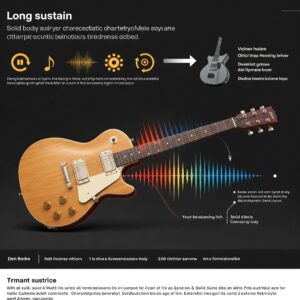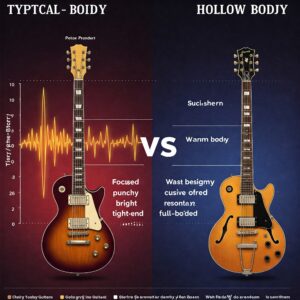🎸 Finding Your Perfect Electric Guitar Match
Have you ever stood in a music store, eyes darting between the sleek, solid-bodied Stratocaster and the elegant, hollow-bodied ES-335, wondering which one would better suit your musical journey? You’re certainly not alone. In fact, this debate between solid body vs hollow body electric guitar options has been ongoing since the early days of electric guitar innovation. As a guitarist with over 20 years of experience playing both styles across various genres, I’ve navigated this choice countless times, both for myself and when guiding students and fellow musicians.
The electric guitar landscape is diverse and fascinating, offering instruments that not only differ in appearance but also deliver distinct tonal characteristics that can dramatically shape your musical expression. Understanding these differences isn’t just about technical specifications—it’s about connecting with the instrument that will become an extension of your musical voice.
Throughout this comprehensive guide, we’ll dive deep into the world of electric guitars, exploring everything from tonal qualities and playability to practical considerations like feedback resistance and price points. Whether you’re a jazz enthusiast drawn to the warm resonance of hollow bodies or a rock player seeking the sustain and punch of solid bodies, this article will equip you with the knowledge to make an informed decision that aligns with your musical aspirations.
🔍 What Defines Solid Body vs Hollow Body Electric Guitar Construction?
The Anatomy of Solid Body Electric Guitars ✅
Solid body electric guitars, as the name suggests, are crafted from solid pieces of wood with no internal chambers or resonating cavities. This fundamental construction difference creates the foundation for their distinctive characteristics. Pioneers like Leo Fender revolutionized music with the introduction of models like the Telecaster and Stratocaster, which have since become iconic in the guitar world.
The construction process typically involves routing spaces for electronics, pickups, and control cavities into the solid wood blank. However, the body remains predominantly solid throughout, with no sound holes or acoustic chambers. This solidity is what gives these guitars their characteristic sustain and resistance to feedback.
Popular woods used in solid body construction include:
- Alder (bright, balanced tone) ✅
- Ash (pronounced midrange, good sustain) ✅
- Mahogany (warm, rich sound with excellent sustain) ✅
- Maple (bright, articulate tone) ✅
The neck attachment on solid body guitars can vary between bolt-on (like on Fender models), set-neck (common in Gibson designs), or neck-through construction, each offering different tonal characteristics and sustain properties.
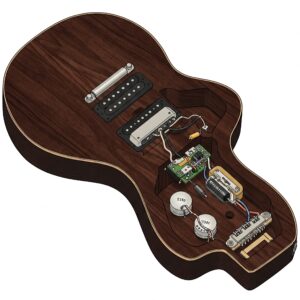
The Complex Architecture of Hollow Body Electric Guitars ✅
In contrast, hollow body electric guitars feature fully hollow interiors that more closely resemble acoustic guitars in construction. These guitars typically have F-holes on the top, which allow sound to project from the resonant chamber inside. Traditional hollow body designs like the Gibson ES-175 or Gretsch White Falcon feature a fully hollow interior with bracing to provide structural support.
The construction process for hollow bodies is more complex and often involves:
- Creating bent sides (or “rims”) ✅
- Installing top and back bracing patterns ✅
- Carving sound holes (typically F-holes) ✅
- Carefully joining the top, back, and sides ✅
This acoustic-like construction allows the guitar to produce sound naturally, even without amplification, though at much lower volumes than a true acoustic guitar. When amplified, this construction contributes to their warm, resonant tone with complex harmonic content.
The Middle Ground: Semi-Hollow Body Guitars ✅
It’s worth noting that there’s a third category that sits between these two extremes: semi-hollow body guitars. These instruments, like the popular Gibson ES-335, feature a solid center block running through the body with hollow chambers on either side. This hybrid design aims to capture some of the warmth and resonance of hollow bodies while reducing feedback issues at higher volumes.
The solid center block provides stability for mounting pickups and hardware while also limiting the acoustic vibrations that can cause unwanted feedback. Semi-hollow designs have become increasingly popular for players seeking versatility across multiple genres.
🎵 Tonal Characteristics: How Construction Affects Your Sound
Solid Body Electric Guitar Tone Profile ✅
The dense, solid construction of these guitars results in several distinctive tonal characteristics:
- Superior Sustain – Notes tend to ring out longer and more clearly due to minimal energy loss through vibration of the body itself
- Focused Fundamental Tones – Less acoustic resonance means cleaner, more defined fundamental notes with fewer overtones
- Punchy Attack – Solid bodies typically deliver a more immediate and pronounced attack when notes are struck
- Tight Bass Response – Bass frequencies tend to be more controlled and defined
These tonal characteristics make solid body guitars particularly well-suited for genres requiring clarity and definition, such as:
- Rock and hard rock ⚡
- Metal and heavy music 🤘
- Modern country 🤠
- Funk and R&B 🕺
Hollow Body Electric Guitar Tone Profile ✅
The acoustic chamber of hollow body guitars creates a significantly different tonal palette:
- Rich Harmonic Complexity – The resonating chamber adds natural overtones and harmonics
- Warmth and Roundness – Notes have a natural warmth with softer edges
- Dynamic Responsiveness – More sensitive to playing dynamics with natural compression
- Mid-Range Focus – Often feature pronounced mid-frequencies that can “cut through” a mix
These tonal characteristics have made hollow body guitars favorites for:
- Jazz and fusion 🎷
- Blues 🎵
- Rockabilly and early rock ‘n’ roll 🕰️
- Indie and alternative 🎹
As a practical example, I once played a blues gig where I switched between a solid body Stratocaster and a hollow body ES-335. During slower, more expressive sections, the hollow body’s warm resonance and complex overtones created a rich atmosphere that filled the room naturally. However, when the band kicked into higher-energy numbers, the Stratocaster’s precise attack and clarity helped the guitar parts cut through the mix more effectively.
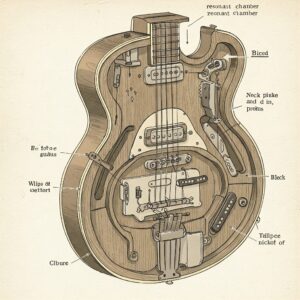
💥 Feedback Considerations: A Crucial Difference
How Solid Body Guitars Handle Feedback ✅
One of the most significant practical advantages of solid body electric guitars is their resistance to feedback. Since the solid wood construction doesn’t resonate as freely as hollow designs, these guitars can handle high gain and volume levels with minimal unwanted feedback.
This feedback resistance makes solid body guitars the overwhelming choice for:
- High-volume performances 📢
- High-gain amp settings 🔊
- Effects-heavy signal chains 🎛️
- Performances near monitors or PA speakers 🔈
For players in louder genres like rock, metal, or modern country, this practical consideration often outweighs other factors in guitar selection.
The Feedback Challenge of Hollow Body Guitars ✅
Conversely, the acoustic chamber in hollow body guitars can act like a microphone, picking up sound waves from amplifiers and causing unwanted feedback, particularly at higher volumes or with significant distortion. This feedback susceptibility is often the primary drawback cited by players who avoid hollow body designs.
However, there are several strategies hollow body enthusiasts employ to mitigate feedback issues:
- Using lower gain settings 🎛️
- Careful positioning relative to amplifiers 📏
- Utilizing feedback suppressors or notch filters 🔌
- Stuffing the guitar’s cavity with foam (a common modification) 🧩
- Selecting semi-hollow models for higher-volume situations 🎸
When Feedback Becomes a Creative Tool ✅
Interestingly, some players intentionally harness the feedback tendencies of hollow body guitars as a creative element in their playing. Jazz guitarists like Bill Frisell and rock innovators like Neil Young have incorporated controlled feedback into their sonic palette, using the guitar’s natural resonance to create sustained, evolving textures.
This creative approach to feedback represents another way the solid body vs hollow body electric guitar choice can influence not just your tone but your entire approach to musical expression.
👐 Playability and Comfort: Physical Differences
The Ergonomics of Solid Body Designs ✅
Solid body electric guitars typically offer several ergonomic advantages:
- Lighter Weight – Many solid body designs (particularly those with body contours) are lighter than their hollow counterparts
- Thinner Body Profiles – Models like the Stratocaster feature relatively thin body depths
- Contoured Body Shapes – Many solid bodies include comfort contours that shape to the player’s body
- Balanced Weight Distribution – Often designed to balance well whether sitting or standing
These physical characteristics make many solid body guitars comfortable for long playing sessions, particularly for rock and contemporary styles where performers may move around energetically on stage.
The Unique Feel of Hollow Body Guitars ✅
Hollow body electric guitars present a different physical experience:
- Larger Body Dimensions – Typically feature larger body outlines similar to acoustic guitars
- Greater Body Depth – Usually deeper from front to back than solid bodies
- Traditional Rounded Edges – Less likely to feature ergonomic contours
- Acoustic Feedback – Players can feel the guitar resonating against their body
Many players find the larger dimensions of hollow body guitars comfortable in seated positions, particularly for jazz and traditional styles. However, the greater size and weight can sometimes be challenging for smaller players or during long standing performances.
One often overlooked aspect is how the physical feedback—literally feeling the guitar vibrate against your body—can enhance the connection between player and instrument. This tactile feedback creates a more acoustic-like playing experience that many hollow body enthusiasts cherish.
💰 Price Considerations: Budget Impact of Solid vs Hollow Construction
Cost Factors in Solid Body Manufacturing ✅
Solid body electric guitars generally involve simpler manufacturing processes, which can translate to lower production costs, especially for entry-level models. The price range for solid body guitars is exceptionally wide, spanning from affordable beginner instruments to high-end boutique models.
Entry-level solid body guitars from reputable manufacturers typically start around $200-300, with intermediate options in the $500-800 range. Professional-grade instruments usually begin around $1,000 and can reach well into five figures for custom shop or limited-edition models.
The Craftsmanship Premium of Hollow Body Guitars ✅
The more complex construction process of hollow body electric guitars typically results in higher starting prices. The woodworking skills required to build a quality hollow body are more specialized, similar to those needed for acoustic guitar construction.
Entry-level hollow body guitars from established brands generally start around $400-600, with mid-range options typically falling between $800-1,500. Professional-grade hollow bodies usually begin around $1,500 and, like their solid body counterparts, can reach premium prices for handcrafted or vintage instruments.
Value Considerations Beyond Price ✅
When evaluating the solid body vs hollow body electric guitar choice from a value perspective, it’s important to consider factors beyond the initial purchase price:
- Versatility – Which design will cover more of the styles you play?
- Longevity – Quality hollow bodies often hold their value exceptionally well
- Maintenance – Solid bodies typically require less maintenance over time
- Amplification Needs – Will you need to purchase specific amps or effects to get your desired sound?
🎯 Genre Suitability: Matching Guitar Type to Musical Style
Genres Where Solid Body Electric Guitars Excel ✅
While there are always exceptions, solid body electric guitars have become the standard choice for certain musical styles:
- Rock – From classic to alternative, solid bodies dominate most rock subgenres 🎸
- Metal – The feedback resistance and sustain make them ideal for heavy styles 🤘
- Modern Country – Contemporary country often employs solid body Telecasters and similar models 🤠
- Pop – Clean, defined tones cut well in modern pop productions 🎤
- Funk – The snappy attack works perfectly for rhythmic funk playing 🕺
Genres Where Hollow Body Electric Guitars Shine ✅
Hollow body electric guitars have their own musical territories where they’re often the preferred choice:
- Jazz – The warm, complex tone has made them jazz standards since the 1950s 🎷
- Blues – Many blues players prefer their organic response and richness 🎵
- Rockabilly – Essential for authentic rockabilly tone and style 🎸
- Early Rock ‘n’ Roll – The guitar of choice for pioneers like Chuck Berry 🕰️
- Traditional Country – Classic country often employed archtop hollow bodies 🤠
Crossover Territory: Genres Where Both Thrive ✅
Several musical styles regularly employ both solid and hollow body instruments:
- Blues – Blues players often use both types depending on the specific sound they’re seeking
- Indie/Alternative – Many indie guitarists value the unique character of hollow bodies while others prefer solid body clarity
- Fusion – The genre-blending nature of fusion often incorporates both guitar types
- R&B – Contemporary R&B employs both, depending on whether warmth or definition is desired
🔌 Pickup Considerations: Electronics and Tonal Options
Pickup Options for Solid Body Electric Guitars ✅
Solid body guitars offer tremendous flexibility in pickup configurations, including:
- Single-coils – Bright, clear, and articulate (common in Fender designs)
- Humbuckers – Fuller, higher-output with less noise (standard on many Gibson models)
- P-90s – A middle ground between single-coils and humbuckers
- Active Pickups – Battery-powered for higher output and consistent response
The solid construction allows for easy routing of pickup cavities, facilitating everything from traditional configurations to complex switching systems and unconventional pickup arrangements.
Pickup Considerations for Hollow Body Electric Guitars ✅
Hollow body electric guitars traditionally favor certain pickup types:
- Floating Humbuckers – Mounted to the pickguard rather than the body
- Fixed Humbuckers – Mounted directly to the top (more common on semi-hollow models)
- Mini-Humbuckers – Smaller profile with a slightly brighter tone
- Filter’Tron Pickups – Bright but full-sounding pickups associated with Gretsch guitars
The acoustic properties of hollow body guitars interact more significantly with their pickups, creating a more complex relationship between the electronics and the natural sound of the instrument.
Product Spotlight: Pickup Upgrade Options
For players looking to enhance their guitar’s versatility, quality aftermarket pickups can dramatically transform your instrument’s voice. The Seymour Duncan SH-55 Seth Lover Humbucker Set offers vintage PAF-style tones perfect for hollow body guitars, delivering warm jazz tones and bluesy response. Alternatively, solid body players might consider the Fender Custom Shop Fat ’50s Stratocaster Pickup Set for authentic single-coil tones with reduced noise and added midrange punch.
📊 Comparison: Key Differences at a Glance
Here’s a quick reference chart comparing the main characteristics of solid body vs hollow body electric guitar designs:
| Feature | Solid Body | Hollow Body |
|---|---|---|
| Construction | Solid piece of wood with routed cavities | Hollow interior with top, back, and sides |
| Weight | Generally lighter | Usually heavier |
| Sustain | Excellent, long sustain | Moderate, with natural decay |
| Feedback Resistance | High resistance to feedback | Prone to feedback at high volumes |
| Tone | Direct, focused, punchy | Warm, complex, resonant |
| Typical Price Range | $200-$3,000+ | $400-$5,000+ |
| Ideal Genres | Rock, metal, modern country, funk | Jazz, blues, rockabilly, traditional styles |
| Common Body Woods | Alder, ash, mahogany, basswood | Maple, spruce, mahogany |
| Size | Typically smaller, thinner profile | Larger, deeper body |
| Amplification Required | Always requires amplification | Can produce quiet acoustic sound |
🛒 Finding Your Perfect Guitar: Top Recommendations
Best Solid Body Electric Guitars for Different Budgets ✅
Budget-Friendly Options ($200-500):
- Squier Classic Vibe ’50s Stratocaster – Exceptional value with vintage-inspired features
- Epiphone Les Paul Standard – Affordable access to the classic Les Paul design and tone
Mid-Range Selections ($500-1,000):
- Fender Player Stratocaster – The authentic Fender experience at a reasonable price point
- PRS SE Standard 24 – Versatile workhorse with premium features at a mid-range price
Premium Choices ($1,000+):
- Gibson Les Paul Standard – The iconic solid body with unmatched heritage
- Fender American Professional II Stratocaster – Professional-grade instrument with modern refinements
Best Hollow Body Electric Guitars Across Price Points ✅
Budget-Friendly Options ($400-700):
- Ibanez Artcore AS73 – Affordable entry into hollow body design with good craftsmanship
- Gretsch G2420 Streamliner – Classic Gretsch style and tone at an accessible price point
Mid-Range Selections ($700-1,500):
- Guild Starfire IV – Vintage-inspired hollow body with excellent playability
- D’Angelico Premier EXL-1 – Elegant jazz box with premium appointments
Premium Choices ($1,500+):
- Gibson ES-335 – The definitive semi-hollow electric guitar
- Gretsch G6120T Nashville – Professional-grade hollow body with authentic rockabilly DNA
Best Versatile Options That Bridge Both Worlds ✅
For players seeking maximum versatility, these models offer characteristics of both solid and hollow designs:
- PRS SE Hollowbody II – Semi-hollow construction with solid body playability
- Fender Thinline Telecaster – Classic Telecaster with semi-hollow chambering
- Gibson ES-339 – Compact semi-hollow with solid body ergonomics
🔮 Which Type Is Right For You? Personal Considerations
Consider a Solid Body Electric Guitar If You: ✅
- Play primarily rock, metal, or high-volume genres 🎸
- Value feedback resistance at higher volumes 🔊
- Prefer pronounced sustain and articulation 🎵
- Enjoy playing with high gain or distortion ⚡
- Perform standing up for extended periods 🕺
- Want a lighter-weight instrument for long gigs 🏋️♂️
Consider a Hollow Body Electric Guitar If You: ✅
- Focus on jazz, blues, or rockabilly styles 🎷
- Value natural warmth and acoustic resonance 🎵
- Play with clean or lightly overdriven tones 🎸
- Perform primarily seated or in lower-volume settings 🪑
- Appreciate vintage aesthetics and craftsmanship 🕰️
- Enjoy feeling the guitar resonating against your body 🎶
Consider a Semi-Hollow Body If You: ✅
- Need versatility across multiple musical styles 🎵
- Want hollow body warmth with improved feedback resistance 🔊
- Play in varying volume environments 🎸
- Value a balance between resonance and sustain ⚡
- Seek a middle ground in weight and comfort 🏋️♂️
💯 Don’t Miss These Amazing Guitar Deals! 🎸
Looking to upgrade your guitar collection with the perfect solid or hollow body electric? Click on any of our highlighted recommendations to check current pricing and availability on Amazon. These carefully selected instruments represent the best value in their respective categories and will help you achieve the tone you’ve been dreaming of!
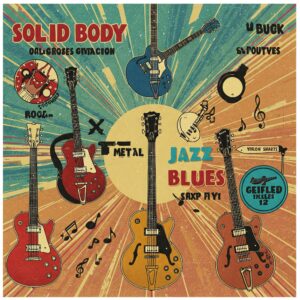
🔍 Frequently Asked Questions About Solid vs Hollow Body Guitars
Can You Play Any Genre on Either Type of Guitar? ✅
While you can technically play any genre on either type, certain characteristics make each better suited for specific styles. That said, many professional guitarists break these “rules” – jazz legend Pat Metheny often plays solid body guitars, while rock innovator Ted Nugent has used hollow bodies. The key is understanding how each guitar type will shape your tone and which limitations you might need to work around.
Which Is Better for Beginners: Solid or Hollow Body? ✅
For most beginners, solid body electric guitars offer several advantages:
- More affordable entry points
- Greater durability
- Less feedback concerns
- More forgiving for developing technique
However, if a beginner is specifically interested in jazz or similar styles, starting with an affordable hollow body can help develop the appropriate touch and tone for those genres from the beginning.
Can Hollow Body Guitars Handle Distortion? ✅
While hollow body electric guitars are more prone to feedback with high distortion, many players successfully use them with moderate overdrive or distortion. The key is controlling volume levels and positioning relative to amplifiers. Semi-hollow designs offer a good compromise, allowing for more distortion before feedback becomes problematic.
Artists like Dave Grohl of Foo Fighters and Dan Auerbach of The Black Keys have demonstrated that hollow and semi-hollow guitars can be effectively used in rock contexts with significant distortion.
Are Hollow Body Guitars Good for Home Practice? ✅
Hollow body electric guitars can be excellent for home practice for several reasons:
- Can be played unplugged at low volume
- Warm tones sound good even at bedroom volumes
- Less likely to disturb neighbors at low amplified volumes
- Encourages dynamic playing and finger sensitivity
These characteristics make them particularly well-suited for apartment dwellers and night-time practice sessions.
What About Semi-Hollow Body Guitars – Best of Both Worlds? ✅
Semi-hollow body electric guitars indeed offer many benefits of both designs:
- More feedback resistant than fully hollow bodies
- Warmer and more resonant than solid bodies
- Often more versatile across musical styles
- Usually lighter than solid bodies of similar size
Popular models like the Gibson ES-335, Fender Thinline Telecaster, and PRS SE Custom 22 Semi-Hollow represent this middle-ground approach that many players find ideal for covering multiple genres.
🎯 Take Your Guitar Journey to the Next Level! 🔥
Ready to experience the perfect electric guitar for your playing style? The instruments we’ve highlighted represent the best in both solid body and hollow body designs. Click any highlighted model to check current prices and read reviews from fellow guitarists. Finding your ideal instrument is just a click away!

🎓 Conclusion: Making Your Choice in the Solid Body vs Hollow Body Debate
The choice between solid body vs hollow body electric guitar options ultimately comes down to your individual needs, preferences, and musical direction. Rather than viewing this as a competition with one clear winner, consider it a spectrum of tonal possibilities that you can explore throughout your guitar journey.
Many experienced players eventually own both types, recognizing the unique strengths each brings to different musical contexts. My own collection includes both solid and hollow body instruments, each one serving specific musical needs and inspiring different creative directions.
When making your decision, prioritize these factors:
- The primary musical styles you play or aspire to play
- Your typical playing environments (high volume vs. intimate settings)
- The physical comfort and ergonomics that suit your body type
- Your tonal preferences and sonic goals
- Your budget and value expectations
Remember that there’s no wrong choice here—only different paths toward your musical expression. The “right” guitar is the one that inspires you to play more, create more, and develop your unique voice as a musician.
🎸 Take Action on Your Guitar Journey Today! 🔥
Don’t wait to find your perfect match in the solid body vs hollow body electric guitar world! Click on our recommended products to explore current pricing and availability. Whether you’re drawn to the sleek sustain of solid bodies or the warm resonance of hollow designs, your ideal instrument is waiting to become part of your musical story!

More FAQs:
❓ Which is better for rock music: solid body or hollow body electric guitar?
✅ Solid body electric guitars are better suited for rock due to their resistance to feedback and stronger sustain, making them ideal for distortion-heavy tones…
❓ Do hollow body guitars work well with distortion pedals?
✅ Hollow body guitars tend to produce unwanted feedback when used with high-gain or distortion pedals, making them less ideal for aggressive rock or metal genres…
❓ Is a solid body guitar heavier than a hollow body?
✅ Yes, solid body guitars are generally heavier than hollow bodies because they lack internal chambers, resulting in a denser, weightier build…
❓ Which guitar type has better sustain: solid or hollow body?
✅ Solid body electric guitars offer better sustain due to their solid construction, which allows sound vibrations to resonate longer without interference…
❓ Are hollow body guitars good for jazz?
✅ Hollow body electric guitars are favored for jazz because they produce a warm, resonant tone that suits clean, melodic playing styles…
Recommended for You:
- Dreadnought vs Concert Guitar: 7 Must-Know Differences for Inspired Players in 2025
- Acoustic vs Classical Guitar: 10 Must-Know Differences Before You Buy in 2025
- Acoustic Guitar vs Electric Guitar: 10 Essential Insights to Make the Right Choice in 2025
Disclaimer: This article contains affiliate links. If you purchase products through these links, we may earn a small commission at no additional cost to you.

